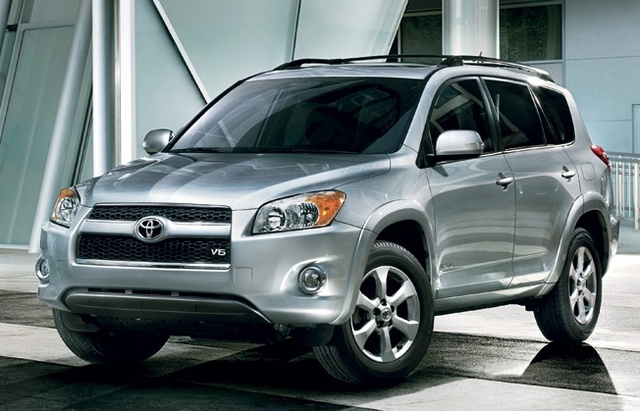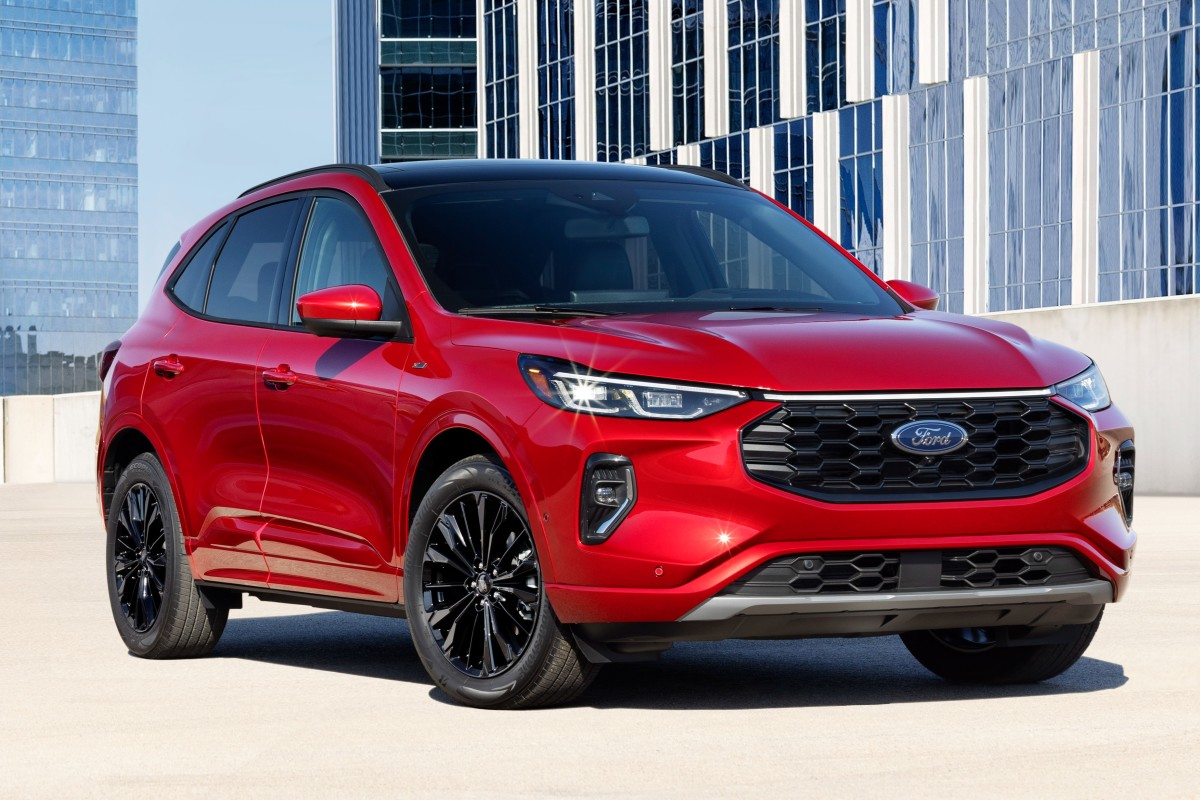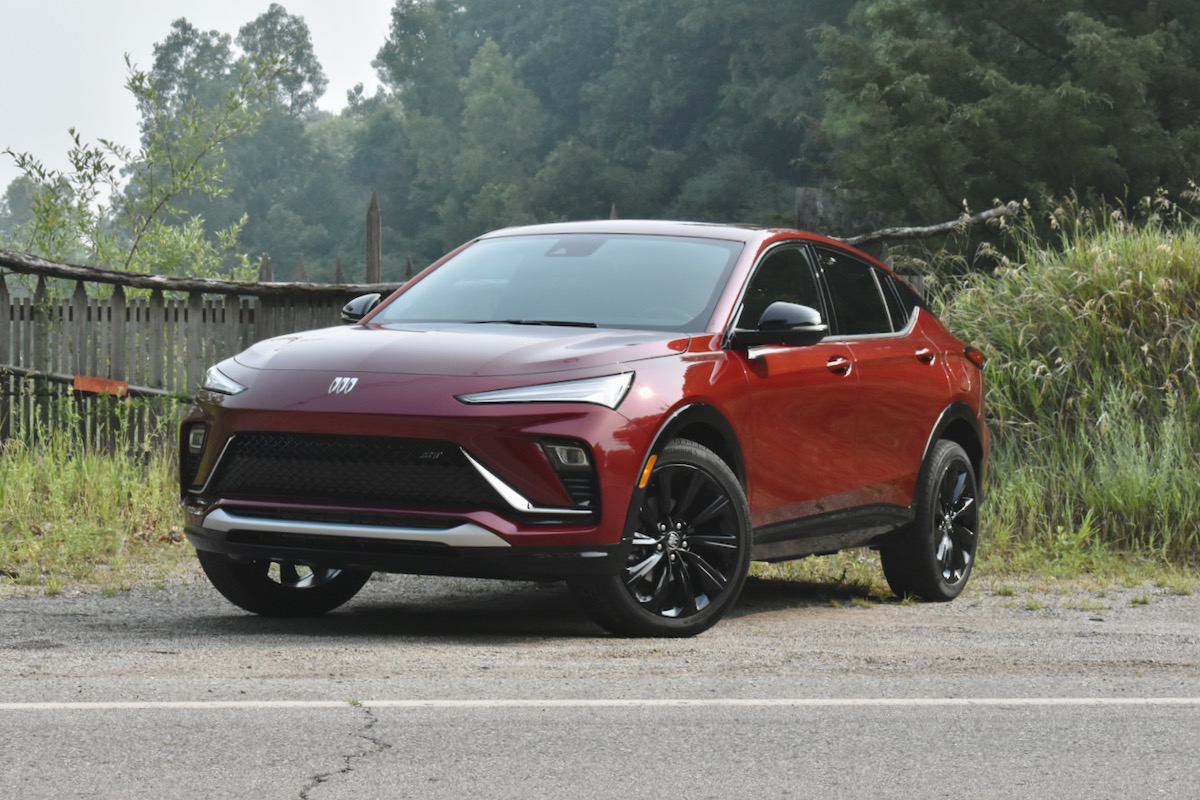There had been earlier products like it, but the Toyota RAV4 truly set the template for today’s small crossover SUVs. Over the past decade, the RAV4 and the imitators its spawned, including the Honda CR-V, Hyundai Tucson, Nissan Rogue, Subaru Forester, and many more, have taken over the passenger car market and displaced sedans as Americans' favorite vehicles that aren’t pickups. The venerable family hauler has now been around for three decades and continues to be a compelling and responsible vehicle choice.
In recent years, Toyota has updated the SUV with efficient plug-in hybrid and hybrid powertrains that deliver surprising performance while maintaining solid fuel economy. The RAV4 is now offered in many configurations, including a rugged Adventure trim with decent trail capabilities. All trims feature more rugged styling than previous generations did, and Toyota sells the SUV in colors previously reserved for legitimate off-roaders like the 4Runner.
That said, the RAV4 is popular because it’s a highly practical choice, not typically an exciting one. Its engines are not usually the most powerful in the class, until pretty recently it wasn’t all that engaging to drive, and its interior is plain and usually a sea of gray plastic.
But It comes standard with a full suite of advanced driver aids, and the top trims offer near-luxury finishes. Aside from the pricey RAV4 Prime plug-in hybrid, Toyota has kept the crossover’s MSRP reasonable despite loading the vehicle with equipment. The 2024 Toyota RAV4 starts at just under $30,000 despite coming with things like adaptive cruise control, which will cost you more on a BMW X3.
RAV4s also have a rock-solid reliability rating in almost all forms. There have been some unusual models for which there is little data, like the two completely different fully electric RAV4s that Toyota built years ago, but in general, this crossover is an inexpensive and hassle-free long-term companion and one that stays cheap over time. Each generation is slightly different and the RAV4 has grown much larger since 1995, but Toyota has never entirely deviated from the original formula.
Here, we’ve outlined each generation and included some advice about what to look for and what to pay.
Toyota RAV4: Cost, Reliability, and the Best Years to Buy
- Frequently Asked Questions
- Toyota RAV4 Pros and Cons
- Toyota RAV4 Generations
- Sixth Generation (2026-Present)
- Fifth Generation (2019-2025)
- Fourth Generation (2013-2018)
- Third Generation (2007-2012)
- Second Generation (2002-2006)
- First Generation (1996-2001)
Frequently Asked Questions
Which Toyota RAV4 years are the best?
Most RAV4s are trusty companions, and outlets like Consumer Reports give all but one model since 2011 above-average reliability ratings. There are a few years of concern, but in most cases, you can rely on the RAV4 to be a low-cost, low-hassle, long-term companion. The real difference is in features. Third-generation RAV4s (2006 to 2012) had optional V6 engines that made them more powerful than most other versions, and there was also a fully-electric version in this generation that many buyers liked. Newer RAV4s have more features, particularly active-safety systems, and that’s a major value add.
What are the worst Toyota RAV4 years?
Third-generation RAV4s may have more power than many of the others, but 2005 to 2010 models also seem to be the worst years. However, many reliability trackers give them average marks. Most of the issues revolve around brakes or suspension components, which might be a sign of age. The 2019 Toyota RAV4, the first year of the current design, also tends to come in for criticism, but the issues seem more serious, with some owners reporting transmission problems. The rest of the current-generation models have above-average reliability ratings.
Is a used Toyota RAV4 a good deal?
Yes. The RAV4 may cost more than many similar crossovers even though it feels and looks a little plainer or not very rugged, but it’s an excellent long-term investment. It’s reliable, safe, fuel-efficient, and full of useful features. Its resale values are high for a reason. That said, it’s best to watch out for signs of neglect, as the RAV4’s trademark reliability can lead to deferred maintenance. Many late-model hybrid RAV4s have also been used for gig driving, which will wear them out faster than normal "civilian" use.
Toyota RAV4 Pros and Cons
Pros:
- Good value, endlessly practical
- Generous standard safety features
- Excellent reliability record
Cons:
- Not exciting to drive
- Can be loud and unrefined
- Basic interiors
Toyota RAV4 Generations
Sixth Generation (2026-Present)
The sixth-generation Toyota RAV4 arrives for the 2026 model year with a comprehensive redesign and a sharp pivot toward electrification. For the first time, Toyota will offer the RAV4 exclusively as a hybrid or plug-in hybrid (PHEV), dropping the traditional gas-only models and sunsetting the separate RAV4 Hybrid model name.
The base 2026 RAV4 comes with a 2.5-liter four-cylinder engine paired with hybrid components, delivering 225 horsepower to the front wheels, marking the first time a hybrid RAV4 has been available with front-wheel drive (FWD). Opting for all-wheel drive (AWD) nudges power output up slightly to 236 hp.
A RAV4 Plug-in Hybrid (PHEV), now with 320 horsepower comes in Woodland, SE, XSE, and GR Sport trims. With the PHEV powertrain, the RAV4 can travel up to 50 miles on just electricity. DC fast charging (via CCS) is now supported on select trims, and a standard 11 kW onboard charger means most owners can fully recharge overnight using a Level 2 home charger.
Toyota structures the sixth-generation RAV4 lineup into three categories: Core, Sport, and Rugged. Core trims (LE, XLE, and Limited) are hybrids only and cater to mainstream buyers. Sport trims (SE, XSE, GR Sport) lean into performance, with the GR Sport available exclusively as a high-output AWD PHEV. Finally, the rugged Woodland trim is designed for light off-roading with features such as all-terrain tires, trail lighting, a raised suspension, and an activity mount for bikes or accessories.
All models include wireless Apple CarPlay and Android Auto, a 12.3-inch digital gauge cluster, and a 10.5-inch infotainment screen, with a larger 12.9-inch version available. The Limited and XSE trims also offer a head-up display and optional nine-speaker JBL premium audio system.
The sixth-generation RAV4's hosts a large, tablet-style infotainment screen prominently atop the dash, while physical climate controls are anchored below the screen. Toyota’s Arene operating system supports over-the-air updates and integrates advanced safety features and media controls.
The 2026 Toyota RAV4 is expected to arrive in dealerships by late 2025. Pricing wasn't included in the sixth-generation's officially announcement, but base models are projected to start between $30,000 and $35,000 when new.
Fifth Generation (2019-2025)
The fifth-generation RAV4 debuted for the 2019 model year, with gas-powered and hybrid versions as in the previous model. In 2021, Toyota added the RAV4 Prime, and impressively capable (and fast) plug-in hybrid range-topper. While the Prime is both speedy and fun to drive off-road, it’s also quite expensive, and its availability has been limited ever since its introduction.
The base Toyota RAV4 LE gets a 203-horsepower 2.5-liter four-cylinder engine and an eight-speed automatic transmission. Front-wheel drive is standard, and all-wheel drive optional. It’s plain, inside and out and the engine is noisy and gruff, but the entry-level RAV4 comes standard with a long list of desirable features, including keyless entry, Toyota Safety Sense, LED daytime running lights, Apple CarPlay and Android Auto, and more. Options include a JBL sound system, navigation, and alloy wheels.
Higher-trim RAV4s, such as the Limited, get many of these extras standard, and in this generation, Toyota also expanded the overall scope of trims. There now also RAV4 Adventure and TRD Off-Road versions that are targeted at competitors like the Subaru Forester and its lifted Wilderness trim, and they hold up fairly well in most comparisons. The RAV4 will never be a hard-core off-roader like its big 4Runner and Land Cruiser brothers, but it’s no longer just a pavement-only pretender.
The Toyota RAV4 Hybrid uses a 2.5-liter four-cylinder and an electric motor that combine for 219 horsepower. It gets standard all-wheel drive, thanks to the electrified powertrain, and it retains its gas-powered counterpart's desirable luxury and entertainment features. This is the best version of the RAV4 thanks to its smoother drivetrain, extra power, and fantastic fuel economy (up to 40 mpg combined), but model-for-model it’s usually $3,000 or so more expensive than the gas-only version and the gulf widens in used models.
Speaking of price, the RAV4 Prime is the most expensive model in the catalog with a nearly $45,000 price tag as a new car (and even more for the high trim Prime XSE). That’s a bunch more than comparable PHEVs like the Hyundai Tucson or Kia Sorento, but the 302-system-horsepower Prime is a very impressive PHEV. It’ll sprint to 60 mph in just over five seconds and its powerful electric motors are really handy off-road. It also comes with many more standard features than the lower-end RAV4s. Even in 2024, new ones tend to have a dealer markup.
You can find gas-only RAV4s from this generation for as little as $18,000 in decent shape, but good low-mileage examples are more likely to sell for $23,000 to $32,000, with higher prices netting you the better-equipped models.
Hybrids cost much more, and they’re hard to find in good shape below $25,000. Nicer ones and higher trim models go for at least $30,000, and in some cases as high as $36,000 even for 2021 or 2022 models. Demand for hybrids is very high, and the RAV4 is one of the best in its class. Expect to pay a premium, though the fuel savings will add up over time. The minimum cost of entry for a RAV4 Prime is $40,000 in 2024, and some used versions are priced so high that ordering a new one might be cheaper.
These years have a good reliability record with one notable exception—2019 models score lower reliability ratings than the other years (and previous generation models). The issues tend to center around the transmission and brakes. However, they’re still quite reliable compared to industry averages.
Fourth Generation (2013-2018)
The fourth-generation RAV4 represented a return to the earlier format, and it would prove to be the most successful version of the crossover yet. It’s also the vehicle that cemented crossovers as the new American family car when it outsold the Camry starting in the summer of 2016. Though it ditched the powerful V6 from the third-gen model, this was also the first Toyota RAV4 model to include a hybrid, which gave it a major market advantage over other compact crossovers. It’s pretty styling, which still looks fresh today, didn’t hurt either.
The 2013 Toyota RAV4, it came with only one powertrain, a 2.5-liter four-cylinder making 176 horsepower and 172 pound-feet of torque mated to a six-speed automatic transmission, with front or all-wheel drive. These early models could return 25 mpg combined, and despite not being very exciting to drive and being rather noisy inside, they were very practical. Toyota also added new features, including a power liftgate and blind spot monitoring, and created more interior space by relocating the spare tire under the vehicle.
Inside, it got upgrades such as an optional 6.1-inch touchscreen infotainment system, automatic climate control, available Softex upholstery, and more standard features, but the biggest changes came with the RAV4’s mid-cycle refresh in 2016. That year brought style and equipment updates, plus the new hybrid, with technology adapted from the Prius.
2016’s updated styling brought LED exterior lighting and a redesigned front end. Inside, there was more sound insulation and updated interior styling, now with an optional 7.0-inch screen in addition to the previous 6.1-inch unit, and a small digital display in the instrument cluster. Active-safety systems were expanded to include standard automatic emergency braking and many optional features including lane departure warnings, rear cross traffic alerts, and even adaptive cruise control with lane centering. Higher trims got much of this gear standard, but it wasn’t optional on base models for a long time.
The Hybrid mated a 150-horsepower 2.5-liter four-cylinder to a trio of electric motors for a total of 194 system horsepower and standard all-wheel drive. It proved not only slightly faster and much smoother than the gas-only version but could also return up to 32 mpg combined, a big number compared to past RAV4s. It proved very popular as soon as it hit lots, and used ones cost considerably more than gas-only RAV4s today, but at first, it’s availability was confined to the higher trims.
By 2018, this generation’s final outing, the Toyota Safety Sense suite (including adaptive cruise control) had been made standard across the lineup and the hybrid option extended to the base-model LE. That year also saw the introduction of the first RAV4 Adventure, which wasn’t as extensively modified for off-roading as the current version, but which did at least get a slight ground clearance lift. Hybrid models in these years actually had more clearance than non-hybrids, and the Adventure was not a hybrid trim.
2013 and 2014 RAV4s have slightly lower reliability ratings than the other years, but the problems owners report, such as issues with interior accessories, are pretty minor. According to every data source this generation of RAV4 is very reliable, in hybrid or gas form.
Gas-powered fourth-generation RAV4s are common, and it’s not too hard to find them with under 100,000 miles on the clock for between $12,000 (for early ones) and $21,000 (for later models). Fourth-generation RAV4 Hybrids are much pricier. It’s very hard to find them under $20,000, and most versions sell for between $22,000 and $28,000. They’re the best model offered in this generation, and since they also tend to come with lots of equipment, they’re just worth more.
Third Generation (2007-2012)
The third-generation RAV4, new for the 2006 model year, marked several major changes. Toyota expanded its size to roughly its current dimensions, taking it out of the subcompact SUV world and into the more popular compact SUV realm. The expanded size (6.7 inches longer overall) allowed Toyota to offer a tiny optional third-row, and this generation is the only one to have that option though it was so small as to be useful only to little kids. It also made a powerful V6 optional, and in time, it developed a second fully electric RAV4 with some help from Tesla.
The base 2.4-liter four-cylinder engine continued, but now with 166 horsepower and in front-wheel drive form, it could return up to 24 mpg. As before, front-wheel drive was standard, and all-wheel drive was optional. The big news, however, was the addition of the 3.5-liter V6. With 249 horsepower, it was the most powerful engine ever offered in a RAV4 until the 2021 RAV4 Prime debuted, and it made for brisk performance without too much loss in economy. V6 RAV4s could return 22 mpg with front-wheel drive and 21 with all-wheel drive.
Visually, the third-generation design was also more daring, with more muscular looks than the previously cute and cheerful designs. The side-hinged tailgate remained, but Toyota dropped the manual transmission entirely.
The lineup now consisted of Base, Sport, and Limited trim levels. Sport trims came with a sport-tuned suspension, while V6 trims included hill ascent and descent control as a standard feature. The second-row seat continued to slide and fold forward, while the optional third-row bench seat folded into the floor. Owners of the Limited trim could add such options as leather upholstery, heated front seats, and a DVD entertainment system.
In 2007, front-seat side airbags and side-curtain airbags joined the standard equipment list for all trims, while in 2009, a mid-generation refresh included updated front and rear ends, a new front grille, and a larger spoiler for the Sport trim, as well as a number of new standard and optional features, including push-button start, a rear-view camera, and a navigation system with a 6.1-inch touchscreen. That same unit would carry over into the fouth generation model in 2013.
At the very end of this generation’s run, Toyota announced a second RAV4 EV. Developed with some parts sourced from Tesla, this version of the RAV4 didn’t appear until 2013, by which time the next generation had arrived, but it was built in small numbers for two years. It offered 104 miles of range from its Lithium-Ion battery pack and zero-to-60 times of roughly seven seconds. Fast charging wasn’t an option, but it could juice to 100% charge in six to eight hours on a 30-amp 240V charger. Only 2,600 were made and all were sold in California. Many of them remain in service, but they’re not easy to find today.
Overall, the third-gen RAV4 has the worst reliability rating fo any generation, but that’s sort of like when a straight A student gets a B+. By the standards of its competitors, this is a very durable vehicle, and many of the issues that owners report are brake and suspension related, meaning they may be age-related or aren’t too hard to fix, unlike blown head gaskets or snapped timing belts on Subaru Foresters.
These are getting to be old vehicles now, but ones in decent shape with fewer than 140,000 miles on the clock should cost around $6,000 to $12,000. V6 models will cost a little more, but not much. They aren’t as common, however. RAV4 EVs are much rarer, but not much costlier. These versions are very hard to find outside of the western states but tend to sell for between $10,000 and $14,000. If you can’t charge at home though, this isn’t the EV for you.
Second Generation (2002-2006)
The second-generation RAV4 debuted for the 2001 model year, and in many ways it was a subtle refinement of the original idea. Toyota dropped the slow-selling two-door model, at least in the U.S., and forgot all about the electric version for another decade. It also made the remaining four-door version larger, 1.3 inches longer and 2.4 inches wider, which resulted in more interior space.
Exterior styling updates were equally subtle but ensured a more muscular and less self-consciously cute appearance. A more rigid body and a re-tuned suspension resulted in an improved, more comfortable ride with minimal flexing and a quieter cabin on the highway. The RAV4 also received a new all-aluminum, 2.0-liter four-cylinder engine with variable valve timing, which helped to improve fuel efficiency. Horsepower jumped by 21 hp, up to 148, and the RAV4 was designated as a low-emissions vehicle for sale in California. Buyers could choose from a five-speed manual or a four-speed automatic transmission.
Inside, front-seat legroom grew by about 3 inches, and headroom increased as well in the front, although both headroom and legroom decreased by about half an inch for rear-seat passengers. The rear seat could be reclined and split 50/50, or slid and folded forward to increase cargo space. Owners again could choose front- or four-wheel-drive configurations, as well as such options as antilock brakes and a power moonroof. The rear tailgate was still side-hinged, opening to the curb side, which wasn’t ideal for loading.
In 2004, the RAV4 received a new 2.4-liter four-cylinder engine, which produced 161 hp. Toyota also made a few minor exterior styling updates, which included new circular fog lights integrated into the front bumper. Toyota added air conditioning, power exterior mirrors, and its electronic stability control system, called Vehicle Stability Control, to the RAV4's standard equipment list, while options included front-seat side and side-curtain airbags. An optional L package added such features as power door locks and an upgraded six-speaker AM/FM audio system with both CD and cassette players. Leather upholstery was also available as a separate option.
These RAV4s are pretty basic by today’s standards, but they have a rock-solid reliability record, and there’s very little to go wrong with them relative to more modern versions. They’re simple, durable vehicles but no longer particularly common. There’s no interest in them from collectors, and most have been used up in daily driving. Clean survivors with under 120,000 miles, if you can find them, should sell for between $4,000 and $8,000.
First Generation (1996-2001)
Loosely based on the Corolla platform and even borrowing some pieces from the Celica, the Toyota RAV4 debuted in the US for the 1996 model year, two years after it had made a huge splash in Japan. It was a brisk seller as soon as it was on sale, even though many traditional car critics didn’t know what to think of it. It was a small SUV like a Suzuki Samurai, but not one designed to go off-road, and it was more like a car to drive than any previous such vehicle, even the crossover 1984-2001 Jeep Cherokee.
Toyota spent five years designing and perfecting it. A concept version of the RAV4 was shown at the Tokyo Motor Show in 1989, and a close-to-production prototype was displayed at the same show in 1993. The final production RAV4 debuted at the Geneva (Switzerland) Auto Show in 1994. Though there had been vehicles like it in earlier eras, like the Matra Rancho and Lada Niva, it was the first proper modern small crossover SUV.
In its initial incarnation, the RAV4 was powered by a 120-hp, 2.0-liter four-cylinder engine, which was mated to either a five-speed manual transmission or an optional four-speed automatic. The RAV4 rode on a car-like fully independent suspension with unibody construction, resulting in good handling. Performance lagged, however, as it took a full 10 seconds for the RAV4 to accelerate from a standstill to 60 mpg.
With its short (compared to larger SUVs) yet wide body, the RAV4 exhibited good stability and maneuverability. It was available with either front-wheel drive or full-time four-wheel drive. Although not designed specifically for off-roading, the vehicle could be equipped with manual-shift four-wheel-drive trims with a center differential lock, which improved off-road performance. Short-wheelbase two-door and long-wheelbase four-door versions were available, with a side-hinged tailgate at the rear. Front airbags were standard, and owners could add antilock brakes as an option.
The RAV4 received a minor facelift in 1998, with a new grille, front end, headlights, and taillights. In addition, the four-cylinder engine received a boost in power, to 127 hp, although owners and reviewers alike still complained about sluggish acceleration.
Minor revisions inside included a new three-spoke steering wheel and updated audio systems. Toyota also introduced a new two-door soft-top convertible trim, as well as a four-door RAV4L Special Edition with leather upholstery and unique exterior colors. The two-door hardtop trim disappeared from the lineup in 1999, leaving only the four-door and two-door soft-top trims.
The first-gen RAV4 not only established the template for the later ones but also established the model’s solid record for quality and reliability. These first-generation models are durable and hard-wearing and can last more than 200,000 or more miles with proper maintenance. They’re rare now, and collectors are already interested in the rarer two-door and two-door soft-top models, but they’re still suitable as reliable daily drivers. They sell for about $4,000 to $9,000, though nice collectible ones might go for more.
Toyota also developed a nickel-metal hydride (NiMH) battery electric version of this RAV4 with a range of 95 miles and a top speed of 78 mph. The automaker leased them to select customers from 1997 to 2001. In 2003, when the leases concluded, Toyota sold the 328 surviving examples as used vehicles. They’re still out there, but the complexity of maintaining them means they’re niche collector's items, not a good choice for an EV you intend to actually use.






